Mediterranean Breakfast Bowl: A Flavorful Start to Energize Your Day
A Mediterranean Morning at Sunrise
The sun had barely peeked over the terracotta rooftops of Santorini, casting warm golden rays across a quaint stone terrace. Sofia, a young nutritionist from Boston, was on a long-awaited escape to reconnect with her Mediterranean roots. On her first morning, she wandered into a sleepy village café and was greeted by a dish that would forever transform her mornings: a Mediterranean breakfast bowl.
It was vibrant—overflowing with crisp cucumbers, juicy tomatoes, creamy hummus, perfectly boiled eggs, and olives plucked from the grove just outside. One spoonful of this colorful bowl and Sofia knew she had found the perfect blend of nutrition, simplicity, and unforgettable flavor.
Inspired by the rich traditions of countries hugging the Mediterranean Sea, this article will walk you through everything about this wholesome breakfast trend: from what goes into a Mediterranean breakfast bowl, why it’s become a favorite for health-conscious eaters, and how to create your own authentic version at home. Along the way, we’ll share regional secrets, answer common FAQs, and dive into the science behind its health benefits.
Don’t miss our Spinach and Feta breakfast idea if you’re craving another savory start!
Table of Contents
Table of Contents

Classic Mediterranean Breakfast Bowl
- Total Time: 15 minutes
- Yield: 1 serving 1x
Description
A hearty and healthy Mediterranean breakfast bowl packed with protein, fresh veggies, and healthy fats. Perfect for a vibrant start to your day.
Ingredients
- ½ cup cooked quinoa (or farro for a more traditional texture)
- 1 large hard-boiled egg, sliced or halved
- ½ cup cherry tomatoes, halved
- ¼ cup cucumber, diced
- 1 tablespoon hummus
- 1 tablespoon crumbled feta cheese
- 4–5 Kalamata olives, pitted
- 1 teaspoon extra virgin olive oil
- ¼ teaspoon za’atar (or sumac for a citrusy flavor)
- 1 tablespoon chopped fresh parsley (optional)
- 1 wedge of lemon, for squeezing over the bowl
- Salt and pepper, to taste
Optional Add-ins:
- 1–2 tablespoons diced red onion
- 1 tablespoon toasted pine nuts or pumpkin seeds for crunch
- A few slices of avocado for added healthy fats
- 1 tablespoon plain Greek yogurt (on the side or dolloped on top)
Instructions
- Place cooked quinoa or farro as the base in a serving bowl.
- Add chopped cherry tomatoes and cucumber around the edges.
- Place sliced boiled egg in the center.
- Add a dollop of hummus and sprinkle crumbled feta on top.
- Scatter olives and fresh parsley.
- Drizzle with olive oil and a squeeze of lemon juice.
- Sprinkle za’atar or sumac for an authentic Mediterranean finish.
- Serve immediately or store components separately for later use.
Notes
- Can be made vegetarian by skipping the egg or using plant-based alternatives.
- For added flavor, marinate the cucumbers in lemon juice and herbs overnight.
- Works well as a make-ahead meal—store components separately.
- Prep Time: 10 mins
- assembly time: 5 minutes
- Cook Time: 0 minutes
- Category: Mediterranean Breakfast Recipes
- Method: No-cook (assemble only, with pre-cooked elements)
- Cuisine: Mediterranean
Nutrition
- Serving Size: 1 bowl
- Calories: 410 kcal
- Sugar: 4 g
- Sodium: 610 mg
- Fat: 23 g
- Saturated Fat: 5 g
- Unsaturated Fat: 16 g
- Trans Fat: 0 g
- Carbohydrates: 32 g
- Fiber: 6 g
- Protein: 16 g
- Cholesterol: 185 mg
The Mediterranean Breakfast Bowl: A Fresh, Flavor-Packed Morning Miracle
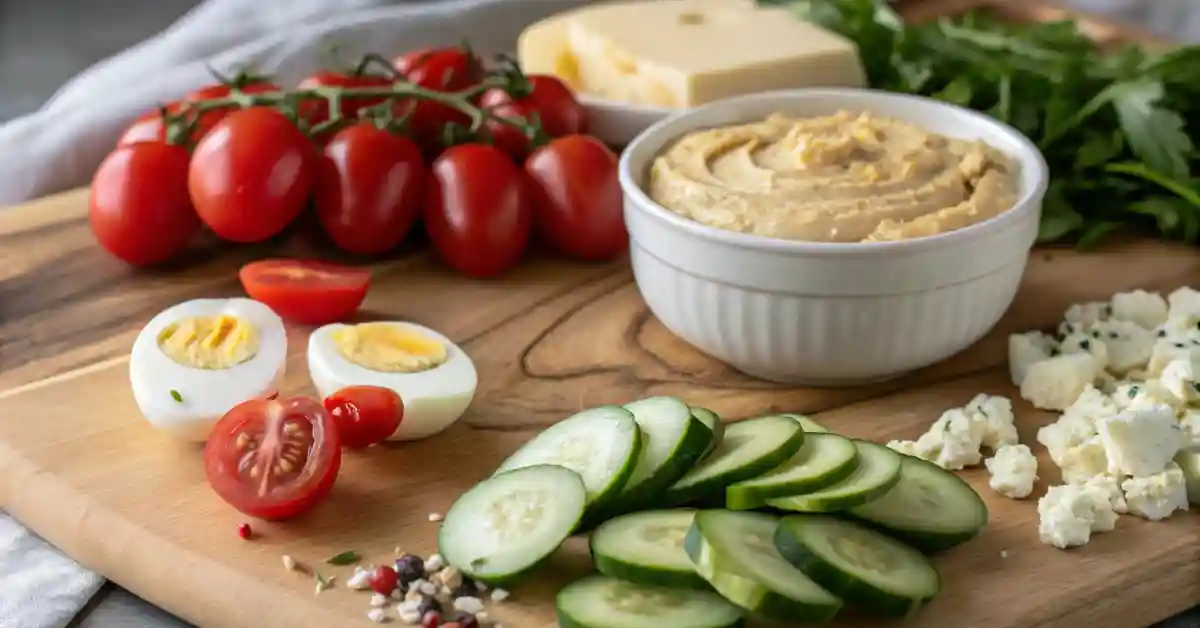
Bursting with Freshness: The Mediterranean Bowl’s Flavor Magic
At its core, a Mediterranean breakfast bowl is a hearty, nutrient-dense dish that combines fresh vegetables, healthy fats, and protein-packed ingredients in one bowl. Unlike sugary breakfast cereals or processed snacks, it brings together real food rooted in Mediterranean traditions. Expect olives, eggs, tomatoes, cucumbers, hummus, grains like farro or quinoa, and sometimes even smoked salmon or labneh.
The popularity of this concept has skyrocketed in recent years, driven by its perfect combination of flavor and health benefits. People are drawn to how customizable it is, allowing them to add seasonal veggies, lean proteins, or even plant-based ingredients for a vegetarian twist.
Why Mediterranean Bowls Are Perfect for Breakfast
Breakfast is often skipped or hurried in the modern world, but Mediterranean cultures treat it differently. A Mediterranean breakfast bowl provides lasting energy through complex carbs, fiber, and heart-healthy fats. The olive oil, nuts, and grains stabilize blood sugar, while the veggies provide antioxidants and hydration. It’s a complete meal that leaves you satisfied but never sluggish.
Bonus tip: Want to change things up? Try our Loaded Veggie Omelette – Denny’s style with a Mediterranean twist.
Must-Have Ingredients for the Ultimate Mediterranean Breakfast Bowl
The 5 Essential Layers of a Truly Authentic Mediterranean Bowl
The foundation of any Mediterranean breakfast bowl lies in its fresh, nutrient-dense ingredients. The Mediterranean diet emphasizes whole foods, and your bowl should reflect that.
Here are the essential components:
| Ingredient Category | Examples |
| Base (Grains or Greens) | Quinoa, couscous, bulgur, farro, arugula, spinach |
| Proteins | Hard-boiled eggs, poached eggs, Greek yogurt, grilled chicken, chickpeas |
| Fresh Veggies | Cucumbers, cherry tomatoes, red onions, spinach, bell peppers |
| Healthy Fats | Kalamata olives, avocado slices, olive oil, tahini drizzle |
| Extras | Crumbled feta, creamy hummus, vibrant fresh herbs, zesty lemon wedges, and toasted pine nuts |
These ingredients can be mixed and matched based on personal preference or what’s in season.
Little Touches, Big Impact: Mediterranean Bowl Flavor Boosters
To elevate your Mediterranean bowl, seasoning is key. Classic herbs and spices such as oregano, za’atar, sumac, parsley, and mint can add depth without overwhelming the dish. A light splash of extra virgin olive oil and a squeeze of lemon juice blend all the flavors seamlessly.
Don’t miss our take on Pancakes with Greek Yogurt and Oats if you prefer something sweet yet wholesome.
Not All Bowls Are Equal: Exciting Regional Twists on Mediterranean Breakfasts
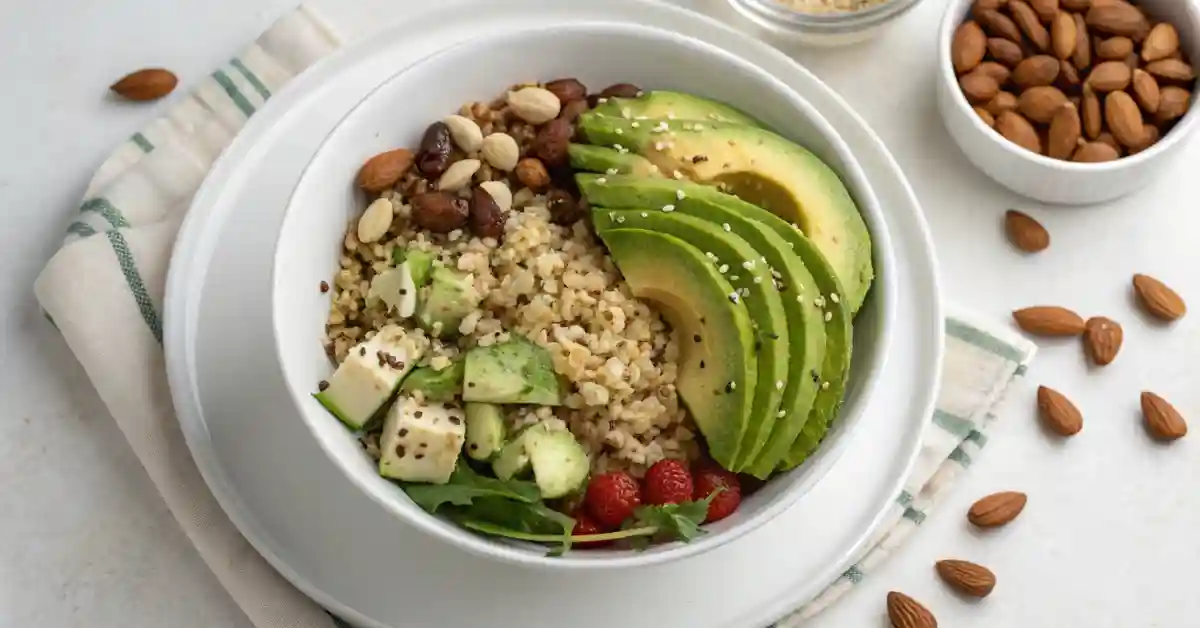
How to Build the Perfect Greek-Inspired Mediterranean Bowl
Greece is known for its love of feta, olives, and yogurt. A Greek-style Mediterranean breakfast bowl might include:
- A base of cooked bulgur or barley
- Slices of cucumber, kalamata olives, cherry tomatoes
- A dollop of tzatziki or Greek yogurt
- Crumbled feta and oregano
- Soft-boiled egg or grilled halloumi
Middle Eastern-Inspired Bowls
In countries like Lebanon and Israel, bowls take on more aromatic and spiced notes:
- Base of couscous or freekeh
- Roasted eggplant, pickled turnips, fresh parsley
- Hard-boiled egg, hummus or labneh
- Drizzle of tahini, sprinkle of za’atar
- Optional: falafel or baba ganoush
Looking for inspiration? Try our Spinach and Mushroom Omelette for a cozy, protein-rich breakfast.
From Heart Health to Energy: How These Bowls Nourish Your Body
The Heart-Protecting Magic in Every Mediterranean Bowl
The Mediterranean Breakfast Bowl isn’t just a beautiful Instagram-worthy plate—it’s also a nutrition powerhouse. Thanks to its roots in the Mediterranean diet, every bowl you build is rich in whole food ingredients that contribute to optimal health.
When you eat a Mediterranean Breakfast Bowl, you’re feeding your body a variety of essential nutrients in one balanced meal. A combination of complex carbohydrates from grains like quinoa and bulgur, lean proteins like eggs or chickpeas, and healthy fats from olive oil and avocado provides long-lasting energy without sugar crashes.
Here’s how these core components benefit your body:
| Whole grains (quinoa, farro) | High in fiber, support gut health, stabilize blood sugar |
| Lean proteins (eggs, Greek yogurt) | Aid muscle repair, provide satiety |
| Healthy fats (olive oil, nuts) | Reduce inflammation, improve heart health |
| Fresh veggies (cucumber, tomato) | Loaded with vitamins, antioxidants, and hydration |
Your Heart Will Thank You for This Breakfast Bowl
The Mediterranean Breakfast Bowl is a heart-friendly choice, especially compared to processed American breakfasts like sugary cereals or fast-food sandwiches. Olive oil, one of the key ingredients in these bowls, is a well-documented source of monounsaturated fat that reduces bad cholesterol (LDL) and raises good cholesterol (HDL).
Additionally, Mediterranean bowls are typically low in saturated fat and high in fiber, which helps lower blood pressure and supports overall cardiovascular function. Including bowls like this in your morning routine has been linked to lower risks of heart disease and metabolic syndrome.
Metabolism Magic: The Bowl That Keeps You Lean
If you’re trying to lose weight or maintain a healthy one, the Mediterranean Breakfast Bowl is a smart strategy. It keeps you full longer due to its protein and fiber content. Eating balanced breakfasts reduces overeating later in the day. The low-glycemic index of many ingredients—like whole grains, legumes, and vegetables—helps control insulin response, avoiding energy spikes and crashes.
Don’t miss our Crustless Spinach and Feta Quiche for another nutrient-packed morning option inspired by Mediterranean flavors.
How to Build Your Own Mediterranean Breakfast Bowl
Bowl-Building 101: How to Layer Flavors Like a Mediterranean Chef
Making a Mediterranean Breakfast Bowl at home isn’t difficult—it just takes a bit of prep and intention. Let’s walk through a reliable bowl-building formula that ensures flavor and nutrition in every bite:
Step 1: Choose Your Base
Select a whole grain or a leafy green foundation. Common options include:
- Quinoa: High in protein and gluten-free.
- Farro or bulgur: Great texture and fiber-rich.
- Arugula or baby spinach: Low-carb and nutrient-dense.
You can also combine greens and grains for extra volume and variety.
Step 2: Add Your Protein
This step is key for satiety and energy. Choose one or more:
- Hard-boiled or poached egg
- Greek yogurt or labneh
- Roasted chickpeas or lentils
- Grilled chicken or smoked salmon (for a pescatarian version)
Step 3: Load Up on Veggies
This is where your Mediterranean Breakfast Bowl starts to pop with color and texture. Use a mix of raw and cooked vegetables:
- Cherry tomatoes, cucumbers, and red onions (raw)
- Roasted bell peppers, zucchini, or eggplant (cooked)
Step 4: Add Healthy Fats
A drizzle of extra virgin olive oil not only enhances flavor but also improves nutrient absorption. Other good fat sources:
- Avocado slices
- Kalamata olives
- Tahini or hummus
Step 5: Finish with Extras
Boost flavor with toppings and seasonings:
- Crumbled feta or goat cheese
- Chopped herbs like parsley or mint
- Lemon juice or vinegar
- Nuts or seeds for crunch
Discover great ideas like our Spinach and Mushroom Omelette to pair with your breakfast bowl for a fuller meal.
The Flavor Boosters That Make Your Mediterranean Bowl Unforgettable
Tips to Elevate Your Bowl
- Balance flavors: Mix creamy (hummus), tangy (feta), fresh (cucumber), and bold (olives).
- Think seasonal: Use what’s fresh and local to maximize flavor and nutrition.
- Make it colorful: A colorful bowl often means a more nutrient-dense meal.
Creating your own Mediterranean Breakfast Bowl is a fun way to start your day with intention, flavor, and health in mind.
Never Skip Breakfast Again: The Busy Person’s Bowl-Prep Guide
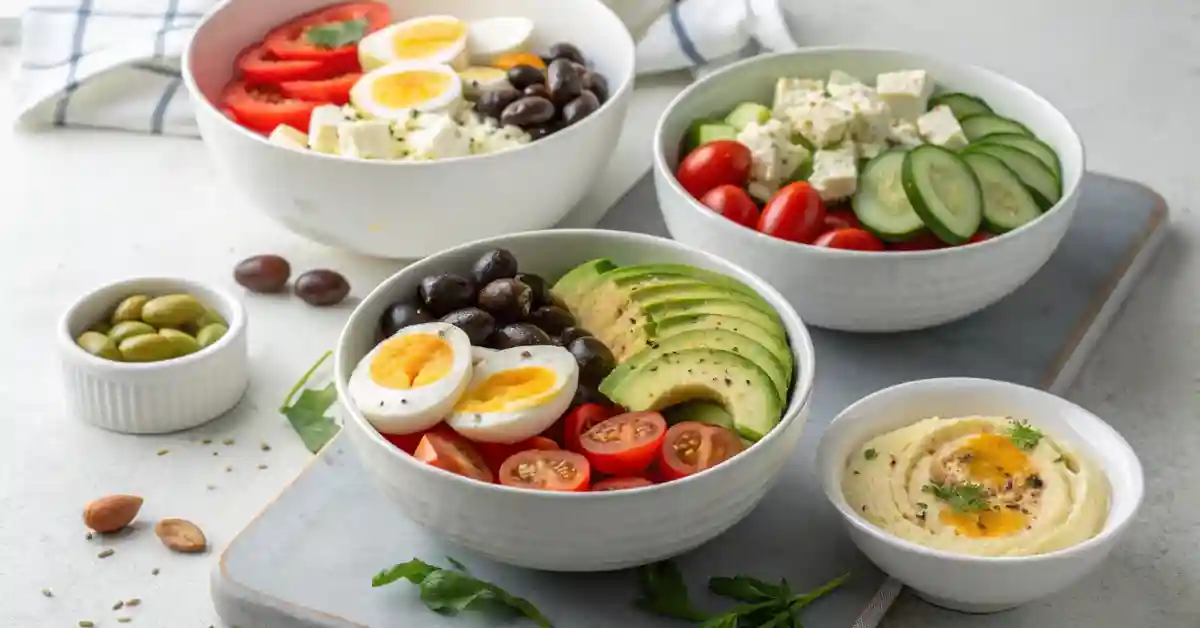
The 15-Minute Prep That Gives You 5 Days of Easy Mornings
One of the best things about the Mediterranean Breakfast Bowl is how easy it is to meal prep. With a bit of planning on Sunday or Monday, you can set yourself up for quick, healthy breakfasts all week long.
Pre-Cook Grains and Legumes
Grains like quinoa, farro, or bulgur can be cooked in bulk and stored in the fridge for 4–5 days. Chickpeas and lentils are perfect make-ahead proteins—just rinse canned beans or cook dried ones in advance.
Storage Tip: Keep cooked grains in airtight containers. For variety, mix in fresh herbs or lemon zest before refrigerating.
Pre-Chop or Roast Vegetables
Slice cucumbers, tomatoes, and bell peppers in advance. Roasted zucchini, eggplant, and onions also keep well and add warmth and depth to any bowl.
| Quinoa | 5 days (fridge) | Add olive oil to prevent drying |
| Roasted veggies | 3–4 days | Store in shallow containers for freshness |
| Hummus | 7–10 days | Make a big batch or buy organic |
Freshness Hacks: How to Store Toppings Like a Kitchen Pro
Store dressings like tahini-lemon or olive oil-based vinaigrettes in small jars. Keep feta crumbles and olives in brine so they stay fresh longer.
Looking for a quick lunch twist? Don’t miss our Spinach and Feta Pasta for a hearty, lunch-friendly Mediterranean idea.
Assembling Your Bowl in 5 Minutes or Less
When it’s time to eat, just layer your ingredients:
- Add your pre-cooked base.
- Top with chopped veggies and proteins.
- Drizzle with dressing and sprinkle with seeds or feta.
Morning Magic in a Bowl: 3 Mediterranean Masterpieces
Classic Mediterranean Breakfast Bowl Recipe
This go-to version offers a perfect balance of protein, fiber, and heart-healthy fats.
Ingredients:
- ½ cup cooked quinoa or farro
- 1 boiled egg (sliced)
- ½ cup cherry tomatoes, halved
- ¼ cucumber, chopped
- 1 tbsp hummus
- 1 tbsp crumbled feta
- 4–5 Kalamata olives
- Drizzle of extra virgin olive oil
- Sprinkle of za’atar
Instructions:
- Layer grains in the bowl as your base.
- Add vegetables, followed by egg and olives.
- Top with hummus, feta, and seasoning.
- Drizzle with olive oil and serve fresh.
This version keeps your morning satisfying without making you feel heavy.
Vegetarian Mediterranean Breakfast Bowl
This variation skips the eggs and dairy but keeps the flavor alive.
Ingredients:
- ½ cup cooked bulgur
- ¼ cup chickpeas (roasted or canned)
- Diced cucumber and tomato mix
- Sliced avocado
- 1 tbsp tahini
- Lemon juice and parsley
Instructions:
- Add bulgur to the bottom of the bowl.
- Layer veggies and chickpeas over it.
- Drizzle tahini, add avocado, and finish with lemon juice.
This plant-based bowl is rich in fiber, iron, and healthy fats—perfect for vegans or dairy-free eaters.
Gluten-Free Mediterranean Bowl
For those avoiding gluten, try this light and crunchy bowl that delivers all the nutrients without any wheat.
Ingredients:
- ½ cup cooked quinoa
- 1 soft-boiled egg
- Spinach or kale as greens
- Grated carrots and beets
- Spoon of labneh or Greek yogurt
- Pumpkin seeds or sunflower seeds
Instructions:
- Start with a layer of quinoa and greens.
- Add veggies and egg.
- Top with labneh and sprinkle seeds for crunch.
Tip: You can find more gluten-free inspiration in our 10 Gluten-Free Mediterranean Recipes.
Frequently Asked Questions (FAQs)
What is a Mediterranean breakfast bowl?
A Mediterranean breakfast bowl is a wholesome combination of grains or greens, fresh veggies, healthy fats like olives and avocado, and protein sources such as eggs, chickpeas, or Greek yogurt. It’s a versatile, filling meal inspired by traditional Mediterranean ingredients.
What is a typical Mediterranean breakfast?
Typical Mediterranean breakfasts include foods like flatbreads with olive oil, tomatoes, cucumbers, cheeses, boiled eggs, olives, yogurt, and herbal tea. The emphasis is on whole, minimally processed foods.
What is a Mediterranean egg dish for breakfast?
Mediterranean egg dishes range from shakshuka (eggs poached in tomato sauce) to omelets with spinach, feta, and herbs. Eggs are often paired with fresh vegetables and served with bread or grains.
What goes in a Mediterranean bowl?
A Mediterranean bowl typically includes a base of grains or greens, a protein (like eggs, yogurt, or legumes), fresh vegetables (such as cucumbers, tomatoes, or greens), and toppings like hummus, feta, and olives.
What is a typical Mediterranean dish?
A typical Mediterranean dish balances fresh produce, whole grains, and healthy fats. Examples include Greek salads, hummus platters, grilled fish with lemon, or pasta with olive oil, garlic, and tomatoes.
Conclusion – Start Your Day the Mediterranean Way
Bringing the vibrant flavors of the Mediterranean to your breakfast routine is more than a trend—it’s a lifestyle. With just a few simple, wholesome ingredients, a Mediterranean breakfast bowl offers energy, balance, and satisfaction all in one bowl.
Whether you’re leaning toward a classic Greek combination, a plant-powered vegan twist, or a gluten-free variant, there’s no wrong way to build your bowl. The secret lies in the freshness, variety, and simplicity of the ingredients.
Don’t miss our delicious take on Spinach and Feta Pizza—another Mediterranean favorite you can adapt for breakfast!

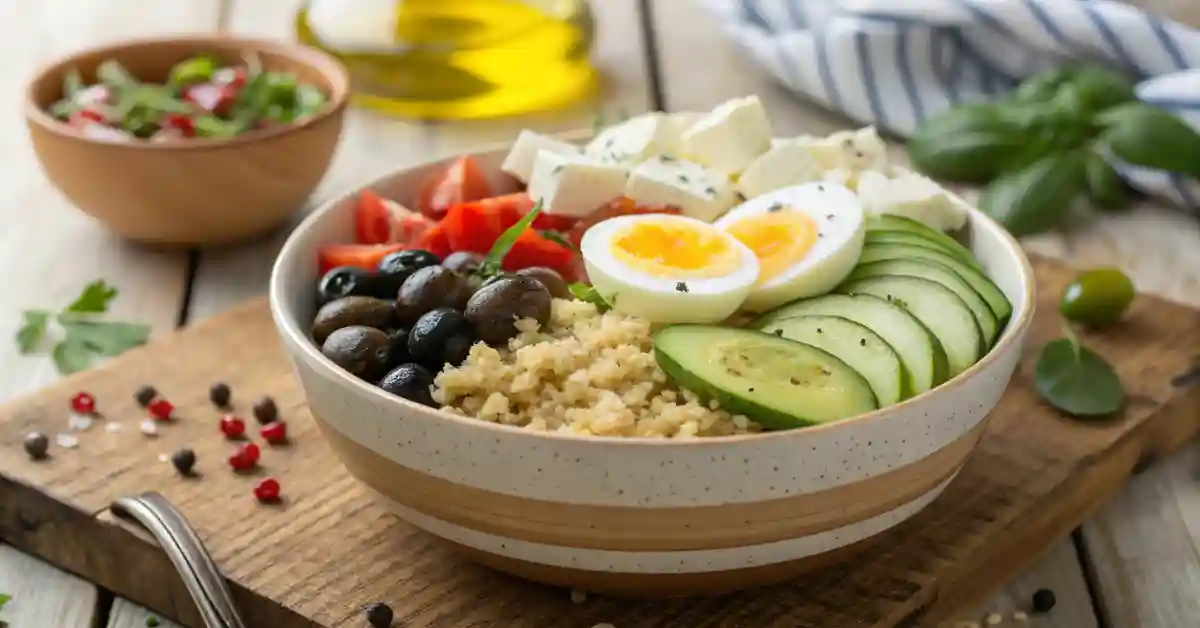
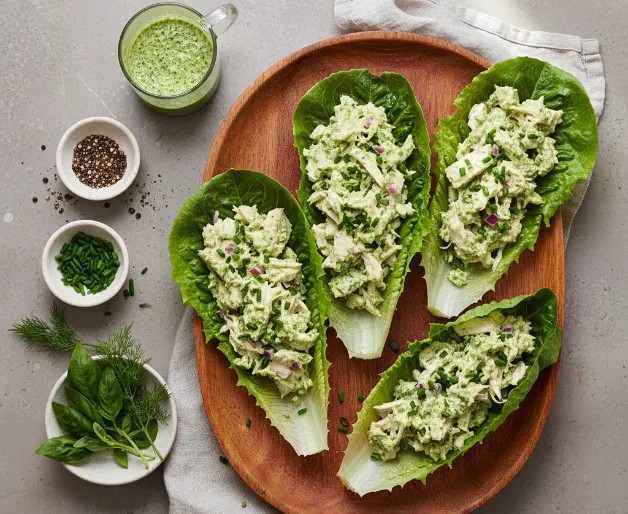
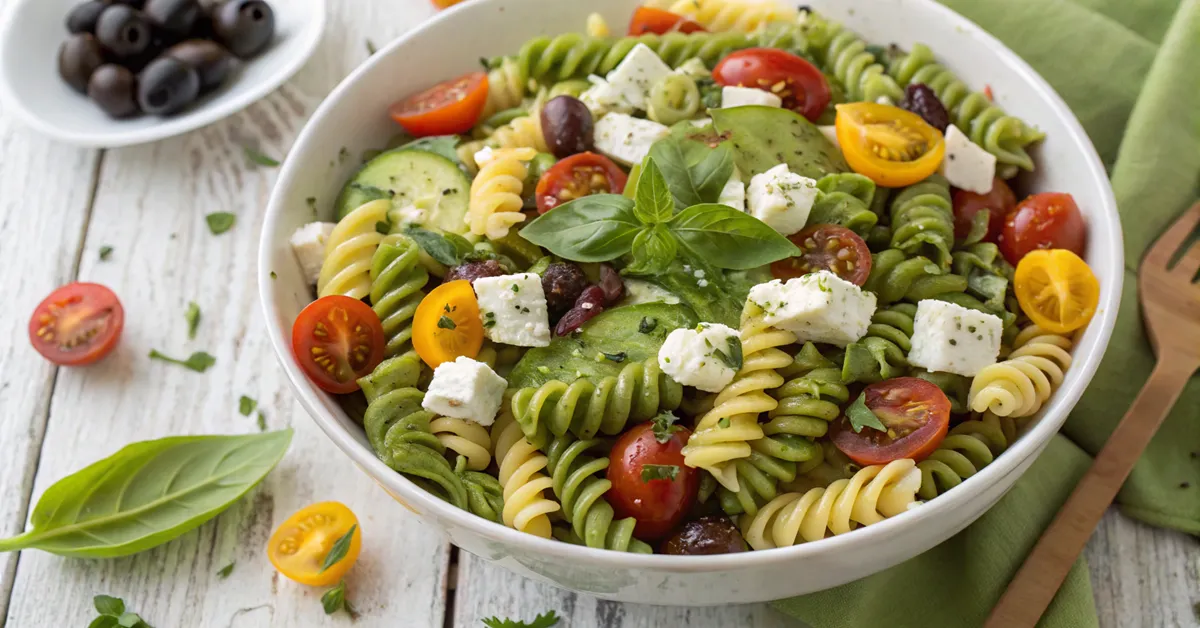
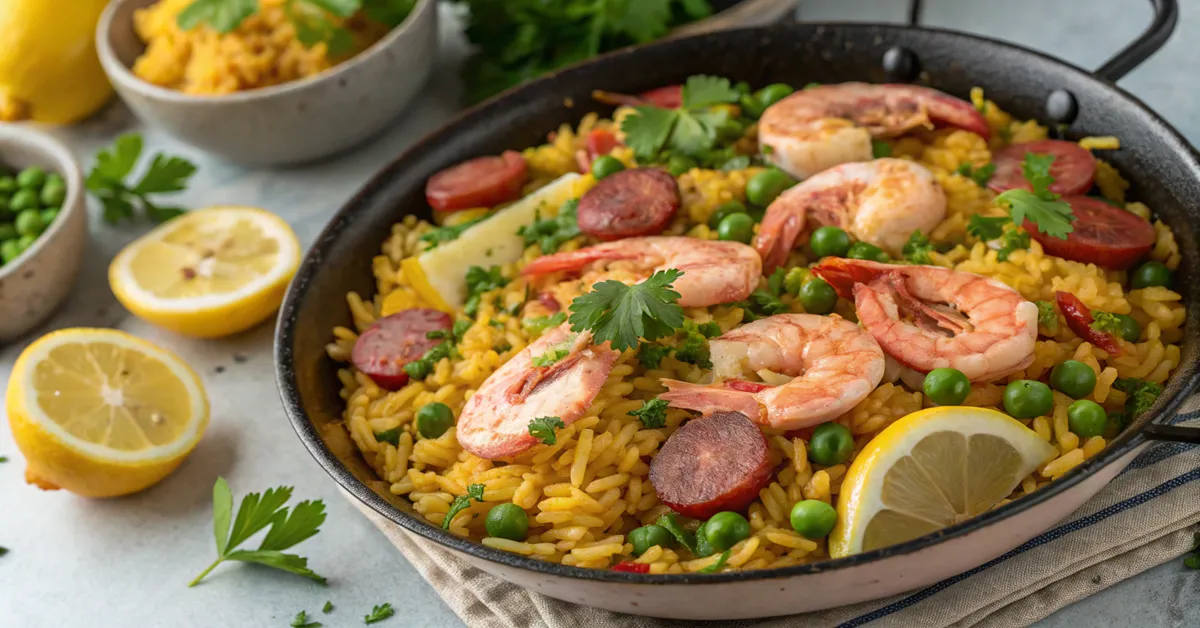
5 thoughts on “Mediterranean Breakfast Bowl: A Flavorful Start to Energize Your Day”